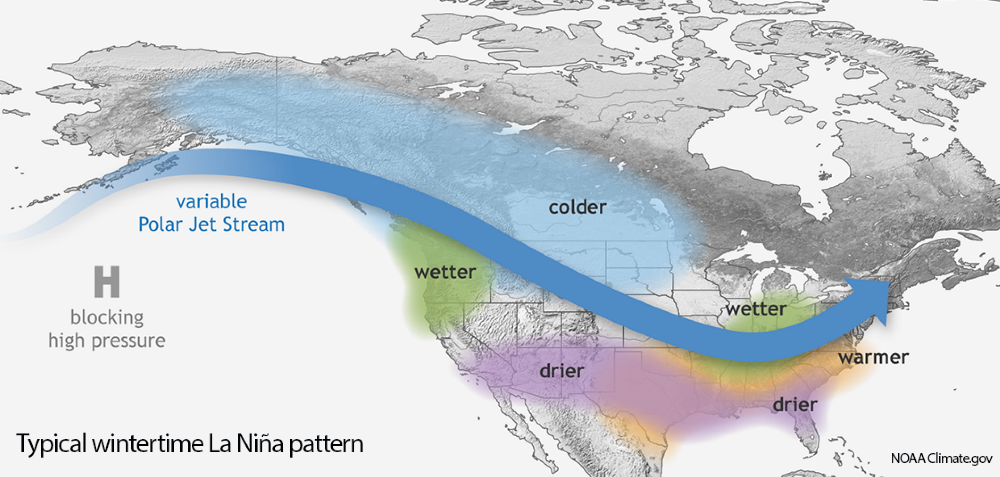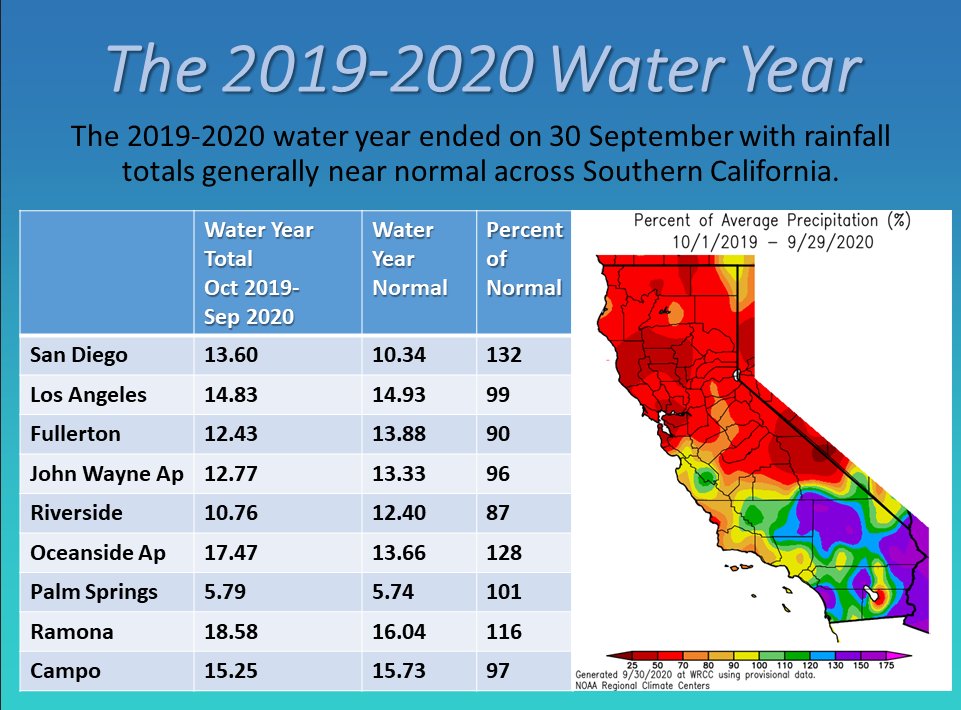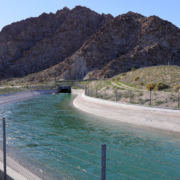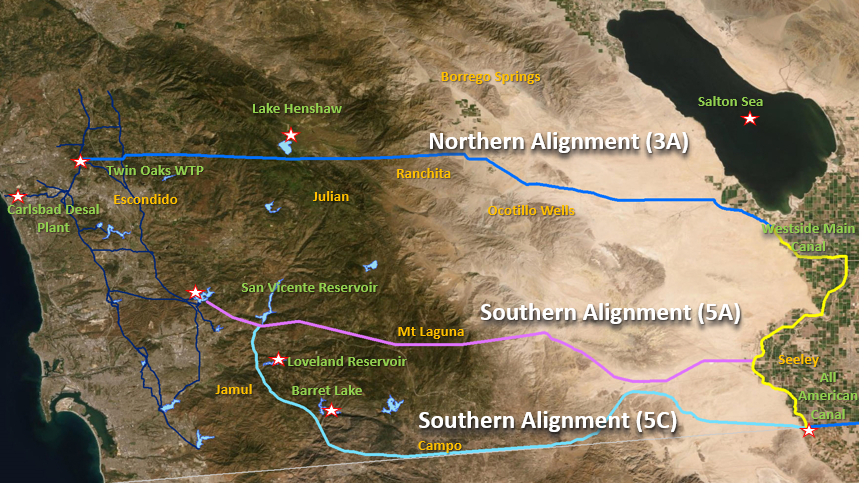El Camino Real Infrastructure Project Reaches Milestone
The Olivenhain Municipal Water District project to replace aging water infrastructure along El Camino Real in Encinitas has now reached the halfway point. After getting underway in March 2020 at the start of the coronavirus pandemic, the project is making steady progress. District officials expect the entire project to be completed in Spring 2021.
During the El Camino Real Potable Water Pipeline Replacement and Green Bike Lane Striping Project, OMWD is replacing approximately 4,700 linear feet of existing 12-inch diameter potable water pipeline along North El Camino Real from Encinitas Boulevard to Garden View Road, and approximately 650 linear feet of existing 12-inch diameter pipeline between Via Molena and Mountain Vista Drive. Water service lines and fire hydrant laterals served by the existing pipelines are also being replaced.
The two pipelines were originally installed in 1961 and 1974, and were fast approaching the end of their lifespan.
El Camino Real infrastructure project – ensuring water supply reliability
The pipeline replacement will reduce water loss and prevent emergency shutdowns due to leaks. This is vitally important for water conservation and to ensure water supply reliability for businesses and residents.
“OMWD has a robust water loss prevention program in place which reduces costs associated with water loss and emergency repairs in addition to conserving one of our most precious resources,” said OMWD Board Director Christy Guerin. “This project is a big undertaking, but it is absolutely important to the health and safety of the community.”
Bike lane striping reduces inconvenience to residents
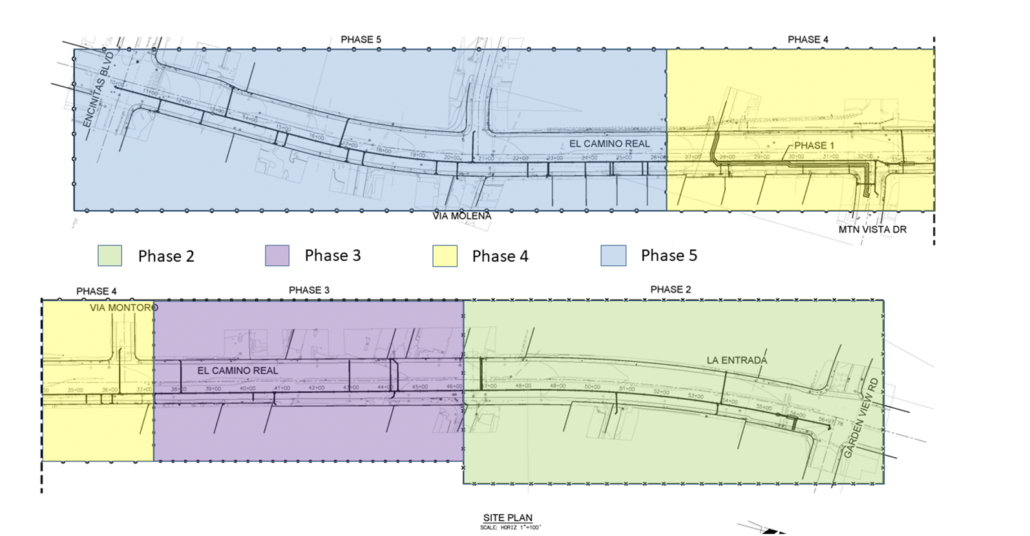
The El Camino Real infrastructure project will work through five phases and is expected to be completed by Spring 2021. Graphic: Olivenhain Municipal Water District
“OMWD and the city work closely together to find opportunities like these where we can streamline projects and reduce the inconvenience they may cause to residents,” said Guerin, who is also the vice chair of the San Diego County Water Authority Board of Directors and former Encinitas mayor and councilmember.
Bike lanes included in El Camino Real infrastructure project
The pipeline replacement is expected to be completed by the end of the year. The City of Encinitas’ green bike lane portion of the project will begin at that time.
The green bike lane portion of the project will provide traffic calming measures, including improvements to safety and mobility for bicyclists along North El Camino Real from Encinitas Boulevard to Leucadia Boulevard by restriping and narrowing travel lanes. In addition, green-colored striping will augment some areas on the bike lanes and new signage and pavement markings will be installed.
Olivenhain Municipal Water District is implementing the lane restriping portion of the project on behalf of the City of Encinitas as an efficiency measure, which is taking place concurrently with the pipeline replacement project.
Collaboration on infrastructure improvements
The two agencies have combined what would normally be two separate, unrelated infrastructure improvement projects into a single effort to improve operational efficiency and reduce the temporary inconvenience of disruptions to area residents and businesses.
“These improvement projects are important for the continued success and safety of the surrounding areas,” said Encinitas Councilmember Joe Mosca. “We understand that anytime you are working in the road, especially in high-traffic areas, there can be traffic and noise impacts. That is why the City of Encinitas and OMWD are working together closely to minimize the time we need to be out there and keep any impacts to the public at a minimum.”
Overnight work

As daytime traffic has returned to normal levels, the City of Encinitas requested work hours be shifted back to overnight. Photo: Olivenhain Municipal Water District
At the start of the project, Encinitas requested that work be done at night to further reduce traffic impacts. During the stay-at-home order, work could be completed during daytime hours due to significantly reduced traffic levels. However, as traffic has returned to normal levels, the City requested work hours be shifted back to overnight.
Olivenhain Municipal Water District officials continue to work closely with Encinitas officials to monitor the project’s impact on traffic on a week-by-week basis and modify the schedule as needed. Both public agencies and the project contractor Teichert Energy and Utilities Group continue to adapt and respond to opportunities to mitigate impacts to the surrounding community while maintaining efficiency.
Project updates are on the water district’s website.



